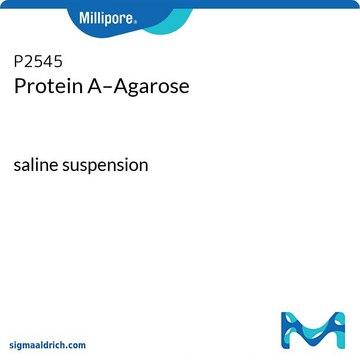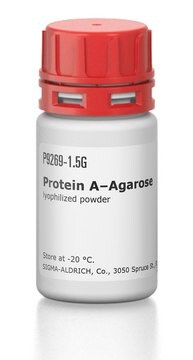Documentos clave
P1406
Proteína A – Agarosa
lyophilized powder
Sinónimos:
Protein A resin
About This Item
Productos recomendados
form
lyophilized powder
Quality Level
extent of labeling
~2 mg per mL
matrix
Cross-linked 4% beaded agarose
matrix activation
cyanogen bromide
matrix attachment
amino
matrix spacer
1 atom
capacity
≥15 mg/mL binding capacity (human IgG)
storage temp.
−20°C
¿Está buscando productos similares? Visita Guía de comparación de productos
1 of 4
Este artículo | 310468 | 62476 | 746460 |
|---|---|---|---|
| assay ≥99.0% (AT) | assay ≥99% | assay ≥99.0% (AT) | assay ≥99% |
| Quality Level 200 | Quality Level 200 | Quality Level 200 | Quality Level 100 |
| grade puriss. p.a. | grade - | grade - | grade - |
| vapor pressure 1.33 hPa ( 547 °C) | vapor pressure - | vapor pressure - | vapor pressure 1.33 hPa ( 547 °C) |
| pH 5.5-7.5 (25 °C, 50 mg/mL in H2O) | pH 6 | pH 5.0-7.5 (25 °C, 1 M in H2O) | pH ~6 (20 °C, 50 g/L) |
Application
Quantity
Physical form
signalword
Danger
hcodes
Hazard Classifications
Eye Dam. 1 - Skin Corr. 1B - STOT SE 3
target_organs
Respiratory system
Storage Class
8A - Combustible corrosive hazardous materials
wgk_germany
WGK 3
flash_point_f
Not applicable
flash_point_c
Not applicable
ppe
Eyeshields, Gloves, type N95 (US)
Certificados de análisis (COA)
Busque Certificados de análisis (COA) introduciendo el número de lote del producto. Los números de lote se encuentran en la etiqueta del producto después de las palabras «Lot» o «Batch»
¿Necesita un COA de muestra?
Esto es un Certificado de análisis (COA) de muestra y es posible que no represente un lote de fabricación reciente para este producto específico.
¿Ya tiene este producto?
Encuentre la documentación para los productos que ha comprado recientemente en la Biblioteca de documentos.
Los clientes también vieron
Nuestro equipo de científicos tiene experiencia en todas las áreas de investigación: Ciencias de la vida, Ciencia de los materiales, Síntesis química, Cromatografía, Analítica y muchas otras.
Póngase en contacto con el Servicio técnico













